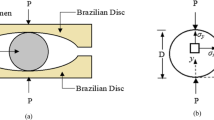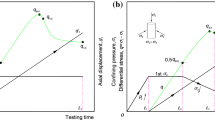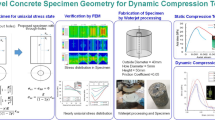Abstract
A set of dynamic triaxial compression experiments at 50, 100, and 200 MPa confinement have been conducted with a modified Kolsky bar on cylindrical ultra-high strength concrete Cor-Tuf specimens of diameter 19 mm and length of 12.7 mm. The modified Kolsky bar utilized is capable of performing a triaxial compression test with a dynamic loading for a confining pressure of up to 400 MPa on specimens with 19.05 mm diameters. The experiment is composed of a hydrostatic phase which occurs at a quasi-static strain rate followed by a dynamic shear phase which occurs at a high strain rate. A set of 28 experiments were conducted at strain rates of 100 and 200 s−1. The experiments show that the fracture strength of the material increases under increasing pressure. The specimens showed higher strength in the dynamic confined experiments than both the quasi-static TXC experiments and the unconfined-uniaxial dynamic tests. The strength increase was in part caused by specimen size difference. Although the trend towards brittle ductile transition is observed the specimens were not loaded in a high enough confinement for the phase change to occur.
Access provided by Autonomous University of Puebla. Download conference paper PDF
Similar content being viewed by others
Keywords
30.1 Introduction
The dynamic response of materials can be drastically different than its response under quasi-static and intermediate strain rates. Modeling events like: earthquakes, explosions, drilling, and structural impact require an understanding of material response at high rates of loading [1]. Moreover, for events like earthquakes and explosions, the loading conditions are not uni-axial but multi-axial [2].
The dynamic triaxial compression experiment is a combination of two experiments: Kolsky bar experiments and triaxial compression tests. Conventional Kolsky bar tests, also known as split-Hopkinson bar (SHPB) tests, are experiments used to determine the dynamic properties of materials under uni-axial load. Conventional triaxial compression (TXC) tests on the other hand are quasi-static tests used to test pressure sensitive materials under a multi-axial stress state.
Frew et al. [2], Lindholm et al. [3], Forquin et al. [4], Gary et al.[5], and Nemat-Nasser et al.[6] developed modified split Hopkinson bar techniques to allow for confinement following the first apparatus developed by Christensen et al. [7]. Christensen et al. [7] in 1972 were one of the first experimenters to modify a split Hopkinson pressure bar with confining pressure vessel capable of pneumatic pressures up to 206 MPa to test 19.05 mm diameter sand stone specimens. Nemat-Nasser et al. developed a 19 mm diameter Hopkinson bar that was capable of confining a specimen to 7 MPa with pneumatic pressure. Lindholm et al. [3] tested Dresser Basalt specimens under triaxial stress states from 0 to 690 MPa with dynamic loading along with formulating a fracture criterion.
The dynamic TXC bar developed by Frew et al. [2] had the capacity to apply confining pressures up to 400 MPa hydraulically. This unique test platform included two pressure vessels instead of the previous methods which only used one pressure vessel. Implementing two pressure vessels allows one cell to load the specimen radially while the other loads the specimen axially.
The most recent development of a TXC Kolsky bar comes from Kabir [8], Kabir and Chen [9], and Martin et al. [10]. A dynamic TXC Kolsky bar, similar to the design developed by Frew et al. [2] except with larger pressure cells, was employed to study granular materials and sand by Kabir and Chen.
30.2 Methods and Materials
Cor-Tuf concretes are known in the family of ultra high performance concretes ranging from 190 to 244 MPa [11]. These ultra high strength concretes contain fine aggregates and powders unlike the coarse aggregates found in common concretes. In fact, the Cor-Tuf prepared included powder grains no bigger than 600 μm. The specimens utilized were fabricated by the Geotechnical Structures Laboratory (GSL) in the Engineering Research and Development Center (ERDC) of Army Engineers in Vicksburg, MS. The Cor-Tuf samples tested by GSL were 50 mm in diameter by 110 mm in length whereas the specimens studied under dynamic load were 19.05 mm diameter and 12.5 mm length.
The apparatus used for these experiments is a modified Kolsky bar capable of triaxially confining a specimen to a desired pressure of 400 MPa and is shown in Fig. 30.1. A similar apparatus was developed by Frew et al. [2]. The current apparatus was developed with the help of Frew [2] and initially assembled by Kabir et al. [9] who used to study dynamic behavior of granular materials under dynamic triaxial loading [8]. The axial stress and strain along are collected during both phases of the experiment and while internal measurements of radial stress and strain were attempted, they were ignored for inconsistencies. The line pressure in the chamber were measured by two Honeywell high pressure transducers with a capacity of up to 517 MPa. The linear variable displacement transducer or linear variable differential transformer (LVDT) is used to collect the axial strain on the specimen during the hydrostatic phase. The dynamic axial stress and strain of the Cor-Tuf, captured by Vishay Micro-Measurements strain gages located on the incident and transmission bars, were calculated through Kolsky bar methods.
Modified Kolsky bar with triaxial confinement [8]
It was necessary to shape the input pulse so that the specimen deformed at a desired constant rate and achieved dynamic stress equilibrium. Copper 110 alloy dampeners, with a measured tensile strength of 310 MPa, were used to pulse shape for all the experiments conducted. There are several variables that dictate the shape of a input pulse: projectile impact velocity, length of projectile, dampening cushion dimensions (diameter, thickness), and the cushion material. Experimenting with the settings allowed us to achieve the desired strain rates in the Cor-Tuf specimens. Due to the gas gun barrel length, a projectile of 30.4 cm length was utilized such that it reached a velocity capable of fracturing the specimen.
30.3 Results
This research project was to supplement the work that had been conducted on Cor-Tuf at GSL in the quasi-static strain rate domain and to provide an understanding of the material behavior in the dynamic domain. A series of experiments were performed in the quasi-static domain by the GSL including: compression, unconfined compression, and triaxial compression on specimens with and without steel fibers. The mean unconfined strength of Cor-Tuf concrete without steel fibers was determined to be 210 MPa. The bulk modulus from hydrostatic compression was determined to be 22.7 GPa. The GSL conducted triaxial compression tests at confining pressures of: 10, 20, 50, 100, 200, and 300 MPa and found that the failure stresses did not vary for confining pressures under 50 MPa. Figure 30.2 is the failure surface determined through GSL data for plain Cor-Tuf without steel fibers (Cor-Tuf2).
This research has been focused on understanding the effects of confinement and high rate of deformation on the behavior on Cor-Tuf. A set of 28 dynamic triaxial compression Kolsky bar experiments were performed on Cor-Tuf specimens with diameters 19 mm and lengths of 12.7 mm. The plain Cor-Tuf experiments were conducted at four confinement levels and at two different strain rates. Specifically, compression experiments at 50, 100, 150, and 200 MPa were performed at strain rates of 100 and 200 s−1.
A conventional uni-axial Kolsky bar analysis was performed to determine the specimen dynamic equilibrium, strain-rate of deformation, and axial stress – axial strain relationships. Figure 30.3 is the combination of results from GSL in Fig. 30.2 and the dynamic TXC experiments. The results plotted are the average principal stress differences versus the mean normal stress. Along with dynamic-confined results, average dynamic-unconfined and mean confined data is also provided.
30.4 Discussions
Figure 30.3 shows that the average failure strength of Cor-Tuf collected with the 19.05 mm diameter specimens have a failure envelope that is higher than the failure envelope found by the GSL. Figure 30.3 includes results from strain rates of 100 and 200 s−1 however they are not distinguishable. As mentioned previously, the specimens tested by GSL were much larger in comparison to the specimens tested with the modified Kolsky bar. Figure 30.4 shows that 19.05 mm diameter specimens tested under quasi-static load in the modified Kolsky bar has a higher fracture strength than specimens tested at the GSL under the same conditions. It was concluded that the higher failure envelope of the Cor-Tuf specimens tested under dynamic triaxial compression conditions was partly due to the specimen size and partly from dynamic effects.
All the experiments shown were pulse shaped so that the strain rate of deformation was nearly constant. From the current experiments, no relationship could be determined between the strain rate and the material’s dynamic fracture strength. Longer striker bars require higher gas pressure and a longer barrel to launch; the amplitude of the input stress wave required to fail the specimen could not be generated with a longer projectile and so the 30.4 cm striker bar was used. With a longer striker bar, a stress wave with a longer period would be possible and allow greater control of the strain rate of the specimen.
References
Kuhn H, Medlin D (2000) High strain rate tension and compression tests. ASM International, Member/Customer Service Center, Materials Park
Frew D, Akers S et al (2010) Development of a dynamic triaxial Kolsky bar, vol 21. Measurement Science and Technology, Institute of Physics Publishing Inc, Philadelphia, pp 105704–105704
Lindholm US, Yeakley LM et al (1974) The dynamic strength and fracture properties of Dresser Basalt. Int J Rock Mech Mining Sci 11(5):181–191
Forquin P, Gary G et al (2008) A testing technique for concrete under confinement at high rates of strain. Int J Impact Eng 35(6):425–446
Gary G, Bailly P (1998) Behaviour of quasi-brittle material at high strain rate. Experiment and modelling. European J Mech-A/Solids 17(3):403–420
Nemat-Nasser S, Isaacs J et al (2000) Triaxial Hopkinson techniques. ASM International, Member/Customer Service Center, Materials Park
Christensen R, Swanson S et al (1972) Split-Hopkinson-bar tests on rock under confining pres-sure. Exp Mech 12(11):508–513
Kabir ME (2010) Dynamic behavior of granular materials, vol 128. School of Aeronautics & Astronautics. Purdue University, West Lafayette. Doctor of Philosophy
Kabir ME, Chen WW (2009) Measurement of specimen dimensions and dynamic pressure in dynamic triaxial experiments. Rev Sci Instrum 80(12):125111–125117
Martin BE, Chen W et al (2009) Moisture effects on the high strain-rate behavior of sand. Mech Mater 41(6):786–798
Williams EG, Graham SS, Reed PA, Rushing TS (2009) Laboratory characterization of Cor-Tuf concrete with and without steel fibers, vol 86. US Army Corps of Engineers, Engineering Research Development Center – Geotechnical Structures Laboratory
Acknowledgment
This research was supported by a contract from ERDC to Purdue University. Boon-Him Lim provided the unconfied dynamic Cor-Tuf results included in this paper.
Author information
Authors and Affiliations
Corresponding author
Editor information
Editors and Affiliations
Rights and permissions
Copyright information
© 2014 The Society for Experimental Mechanics, Inc.
About this paper
Cite this paper
Mondal, A.B., Chen, W., Martin, B., Heard, W. (2014). Dynamic Triaxial Compression Experiments on Cor-Tuf Specimens. In: Song, B., Casem, D., Kimberley, J. (eds) Dynamic Behavior of Materials, Volume 1. Conference Proceedings of the Society for Experimental Mechanics Series. Springer, Cham. https://doi.org/10.1007/978-3-319-00771-7_30
Download citation
DOI: https://doi.org/10.1007/978-3-319-00771-7_30
Published:
Publisher Name: Springer, Cham
Print ISBN: 978-3-319-00770-0
Online ISBN: 978-3-319-00771-7
eBook Packages: EngineeringEngineering (R0)








